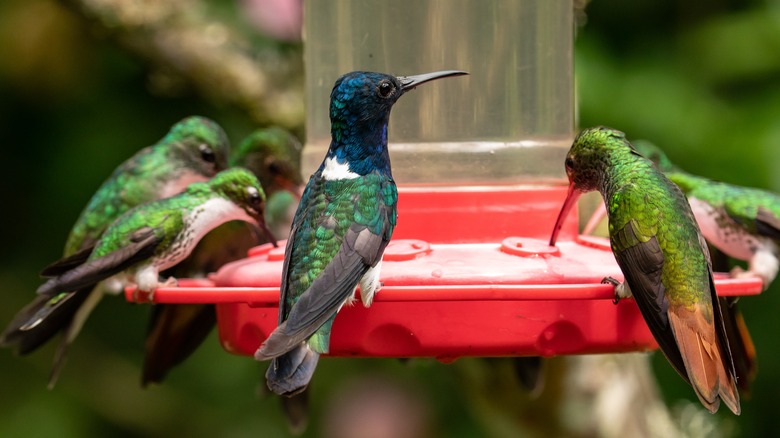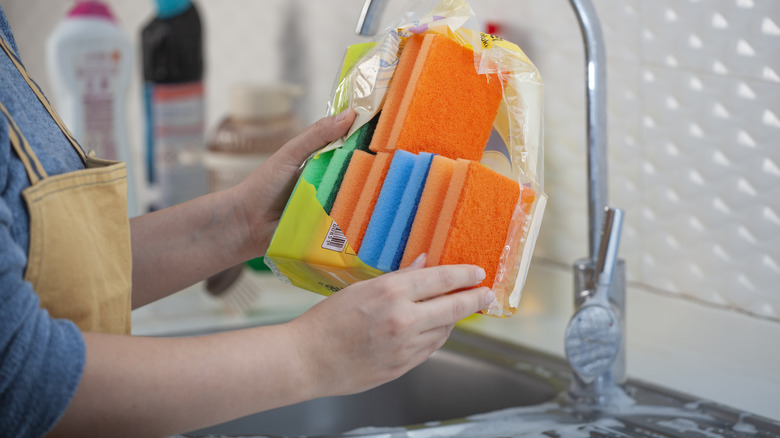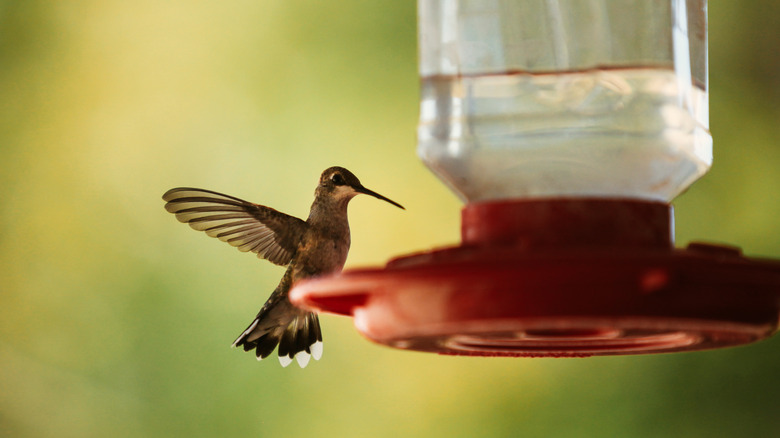Think Twice Before Using A Sponge To Clean Your Hummingbird Feeder. Here's Why
Hummingbirds are tiny and full of energy, making them a favorite among bird watchers. Homeowners often hang hummingbird feeders to attract these birds, which makes it easy to peek at them through a window and observe their often colorful feathers. Hummingbird feeders are typically filled with a homemade sugar and water mixture that is similar to nectar, which makes up a large part of a hummingbird's diet. This sticky substance makes it difficult to clean these feeders, so you may be tempted to use an abrasive sponge to help scrub the sugar and water mixture away. Unfortunately, this poses a health risk to both you and the hummingbirds that eat from the feeder. This is because sponges spread the bacteria and diseases that are often found in hummingbird feeders.
Some of these diseases can even infect humans. In fact, experts advised against using hummingbird feeders due to the risk of spreading avian flu (H5N1) during an outbreak in 2022. "Because the science is unclear on the role of songbirds in this current H5N1 outbreak, one consideration is to not encourage birds to gather together at places such as bird feeders or bird baths," the University of Minnesota Raptor Center's Dr. Victoria Hall told Alabama.com at the time. "These are places where things like viruses could easily be exchanged between individuals." Also, according to the World Health Organization, avian flu can be spread to humans. With this in mind, you may want to consider switching to another cleaning procedure for your hummingbird feeder.
The science behind why you should not use a sponge to clean your hummingbird feeder
Let's dive into the science behind why sponges should not be used to clean hummingbird feeders. First, sponges in general present a very bacteria-friendly environment. "A single sponge can harbor a higher number of bacteria than there are people on Earth," researcher Trond Mretr told ABC 7 News. Mretr was among a group of researchers who conducted a study published in the Journal of Applied Microbiology (via the National Library of Medicine) about how much bacteria a sponge harbors compared to a dishwashing brush. As you may have guessed, they found far more bacteria in the sponge. "Salmonella and other bacteria grow and survive better in sponges than in brushes; the reason is that sponges in daily use never dry up," Mretr explained to ABC 7 News.
This finding is particularly concerning when it comes to using sponges to clean hummingbird feeders because salmonella can be transmitted from birds to humans, according to the Washington Department of Fish & Wildlife. Many people reuse sponges around the house, which is why there is a risk of spreading salmonella not only to other birds but also to humans when using a sponge to clean bird feeders. As a result, it is also recommended to use gloves when handling a bird feeder.
How to clean a hummingbird feeder safely
Although sponges should not be used to clean hummingbird feeders, you can still use other cleaning tools to get the job done. To clean your feeder properly, start by wearing latex or cleaning gloves to protect your hands. Next, empty any remaining nectar from the feeder and discard it. Disassemble all components so that all parts can be cleaned adequately. If you own a glass feeder, you can create a solution using hot water and dish soap to dissolve all of the residue from your homemade nectar mixture. Those with plastic feeders should use a vinegar and water mixture to accomplish this instead, to avoid damaging the material.
After allowing all components to soak in either mixture, use a bottle brush to scrub away any remaining residue. The cleaning brush is a better option than a sponge because, as previously mentioned, it harbors less bacteria. Finally, dry all parts with a cloth before reassembling the bird feeder. Remember: It's very important that you don't reuse any of these cleaning tools or materials around your home to avoid the spread of disease or bacteria.


